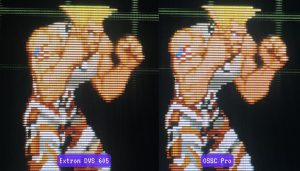The Extron EDID Method is a novel and exclusive way to display HD video sources in 240p on a standard definition CRT. The Extron IN1606 and DVS 605 are 2 of several (or possibly many) compatible scalers that interface with the Product Configuration Software (PCS) to upload custom EDID.bin files to output 240p. My first attempt with the Extron IN1606 scaler was floundered when the custom 240p resolution I created using the Extron EDID Manager would only output sub-60Hz, resulting in noticeable frame skips.
I am happy to report that my second attempt at the Extron EDID Method using a DVS 605 was far more successful by uploading this pre-made 240p EDID for RGB output thanks to Filthy Pants.
I need to preface that you must have an Extron Insider account to download the PCS program to upload custom resolutions. This is a big blow to anyone with an interest in downscaling that does not have access to the PCS. If you are an Extron Outsiders, not to worry, there are alternatives.
UPDATE WITH LINK: There is an upload of the PCS program that does not require an Extron Insider account, just be sure to download the first option which does not require a sign in (FW 4.7.1).

The DVS 605 has 3 HDMI inputs and 2 DB15 connectors which can accept composite, S-Video, component, and RGB. Analog RGB or component can output via DB15, and using a DAC allows a second simultaneous scaled output via HDMI.
Both the IN1606 and the DVS 605 were very flexible with input resolutions up to 1080p, but will only downscale to 240p and not 480i. The DVS 605 teeters on the border of what may be considered acceptable for lag when used for gaming. When downscaling to 240p, all progressive input resolutions have approximately 1-2 rolling frames of lag, and 480i had a de-interlacing tax of an additional frame, totalling to 2-3. On the DVS 605 with AFL turned on, progressive inputs have 17msec (1 frame) of lag, and 33msec (2 frames) for interlaced. Thanks to ShankMods for pointing this out. In contrast, the IN1606 only has 0.2-1.3 frames of lag for progressive inputs and 1.25-2.25 frames when downscaling 480i sources.
The Extron EDID Method is extremely versatile for displaying all manor of content in 240p. Blending vertical lines with a fine balance of sharpness and detail helps mitigate vertical shimmer for non-240p 2D pixel art, reduces jaggy outlines of linear and 3D geometric shapes, and can restore 240p almost as sharp as a line decimator like the OSSC Pro. It surpasses the Corio2 tvONE 750 for image clarity and picture controls, with fluid HV positioning and image presets/recall function.
In summary, the Extron EDID Method of downscaling can be a viable option for anyone with a compatible scaler, provided a link to the PCS software remains available which does not require a login. Compatible Extron scalers are a 240p downscaling powerhouse, but for those also wanting a scaler with 480i output, see the table below:

